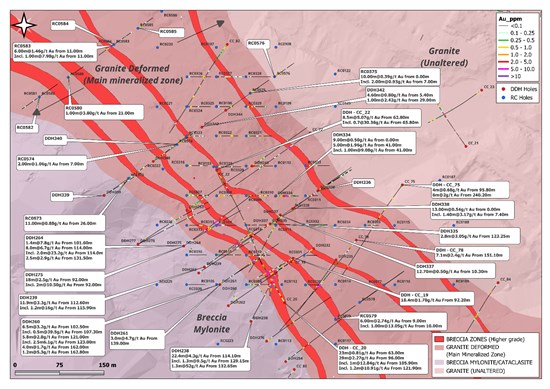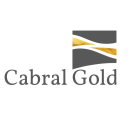Gold Rally Meets Growth: Cabral's Perfect Storm

Cabral Gold expands PDM oxide blanket 50%, discovers two new primary zones as gold hits $3,895/oz. Low-cost starter operation targets 78% IRR amid record prices.
- Gold futures reached all-time highs at $3,895.22/oz on September 30, 2025, driven by Federal Reserve rate cut expectations and safe-haven demand, providing unprecedented tailwinds for gold producers.
- Cabral Gold expanded its gold-in-oxide blanket by 50% (from 0.26 km² to 0.39 km²) and discovered two new primary mineralization zones, increasing the number of mineralized zones from two to four, all open for expansion.
- The updated Preliminary Feasibility Study shows a post-tax IRR of 78%, NPV of $73.9 million, and rapid 10-month payback period at $2,500/oz gold, well below current spot prices.
- All-in sustaining costs of $1,210/oz provide substantial margins at current gold prices exceeding $3,800/oz, positioning Cabral among potential low-cost producers in the sector.
- With construction financing underway and engineering advancing for the oxide "starter" operation, Cabral is transitioning from explorer to near-term producer in a historically favorable gold price environment.
Introduction: When Timing Meets Opportunity
In commodity investing, the convergence of rising prices and expanding resources rarely aligns so perfectly. As gold futures shattered records on September 30, 2025, climbing above $3,895 per ounce, Cabral Gold Inc. announced a 50% expansion of its gold-in-oxide blanket at the PDM target, coupled with the discovery of two entirely new zones of primary gold mineralization. This dual catalyst of macro tailwinds meeting micro developments positions Cabral at an inflection point that merits serious investor attention.
The September 30 commodity markets underscored precious metals' dominance, with gold's record-breaking performance accompanied by silver hitting $47.41 per ounce while base metals showed mixed results. Market expectations pointing toward further Federal Reserve rate cuts and risks of a US government shutdown fueled safe-haven demand, driving gold's momentum in a way that appears structurally sound rather than speculative. For junior gold developers like Cabral, operating in a gold environment above $3,800/oz versus planning around $2,500/oz base cases creates extraordinary margin expansion potential.
Company Overview: Brazil's Emerging Gold Story
Cabral Gold Inc. is a junior resource company focused on Brazilian gold projects, with its flagship asset being the Cuiú Cuiú gold district. This historic region has produced placer gold for decades, and the company holds an existing NI 43-101 compliant resource base. It is indicated resources in fresh rock total 12.29 million tonnes grading 1.14 g/t.
The PDM target sits 2.5 kilometers northwest of the Central deposit and lies within a larger soil anomaly trend extending over 5 kilometers. The company's strategic approach involves developing near-surface oxide material first, requiring lower capital expenditure, while systematically delineating deeper primary mineralization that could support longer-term operations.
Key Development: The PDM Expansion & Discovery

Terms: g/t = grams / tonne, m = metres, Au = gold
The September 25, 2025 announcement detailed results from 10 reverse circulation (RC) holes and 6 diamond drill holes at the PDM target. The drilling delivered high-grade intercepts within the oxide and saprolite zones, with the most notable result being 6 meters grading 2.74 g/t gold from 9 meters depth, which included 1 meter at 13.06 g/t. Alan Carter, President and CEO of Cabral Gold, stated in the company's press release:
"These latest drill results from the PDM target at Cuiú Cuiú have extended the surface extent of the gold-in-oxide blanket by 50% indicating a significantly larger gold-in-oxide resource base."
Specifically, this drilling expanded the blanket's surface area from 0.26 square kilometers to 0.39 square kilometers. The drilling program intersected two new zones of primary gold mineralization beneath the oxide blanket. These zones trend northwest-southeast, parallel to previously identified mineralization, with strike lengths exceeding 600 meters. Carter emphasized the significance of this discovery:
"Of greater importance, however, is the fact that additional drilling has increased the number of NW trending primary mineralized zones in the underlying intrusive rocks at PDM, from two to four."
This doubling of the primary zone count fundamentally changes PDM's scale potential. Carter further noted that "all of these mineralized zones remain open along strike to the north and south and at depth," indicating substantial room for resource expansion through continued drilling. Brian Arkell, serving as Qualified Person under NI 43-101 standards, certified the technical disclosure.
Strategic Significance: Economics in a High Gold Price Environment
Cabral's updated Preliminary Feasibility Study, released July 29, 2025, outlined specific economics for the gold-in-oxide "starter" operation. Capital expenditure is projected at $37.7 million, with the project delivering a post-tax internal rate of return of 78% and net present value of $73.9 million at a base case gold price of $2,500/oz. The payback period is estimated at 10 months. These metrics were calculated when gold traded well below current levels, before the metal's surge to record highs documented across global markets on September 30.
With gold futures reaching $3,895.22/oz internationally and Indian MCX December contracts hitting all-time highs of ₹117,788 per 10 grams, approximately 56% above the PFS base case, the project's economics are substantially enhanced compared to the published study. All-in sustaining costs are projected at $1,210 per ounce. At current gold prices, this implies operating margins of approximately $2,685 per ounce before taxes, positioning the project favorably on the global cost curve. The divergence between precious metals and base metals, with aluminum declining 0.12% and zinc dropping 0.26% on the same day gold surged, underscores that gold's strength stems from monetary and safe-haven factors rather than broad commodity inflation.
The company's approach focuses on the oxide blanket, which requires simpler processing than fresh rock material. By targeting the $37.7 million capex oxide operation first rather than a larger-scale fresh rock development, Cabral aims to achieve production with lower financing requirements. The expansion of the oxide blanket to 0.39 km² directly enhances this strategy, providing a larger resource base for the near-term operation while the four primary zones underneath offer longer-term production optionality. Lower interest rates, anticipated through further Federal Reserve rate cuts, reduce the opportunity cost of holding gold while improving the economics of capital-intensive mining projects through reduced financing costs.
Ongoing Activities & Near-Term Catalysts
Cabral disclosed ongoing drilling at the Mutum target using reverse circulation rigs, with programs also underway at Machichie Main and Machichie NE targets. The company stated that assays are pending for diamond drill holes DDH342 and DDH344. The objectives of the drilling program were explicitly stated: to expand the oxide resource and define a maiden resource for the primary zones beneath the oxide blanket.
With four mineralized zones now identified at PDM, all open along strike and at depth according to Carter, the upcoming drilling results could significantly expand the resource base beyond the already-enlarged 0.39 km² oxide footprint. The company indicated that construction financing efforts are underway for the gold-in-oxide starter operation, with engineering work advancing and the company building its construction and operations team in preparation for development.
The timing of these activities coincides favorably with the gold price environment. Securing project financing when gold trades near $4,000/oz, driven by risks of US government shutdown and market expectations of further Federal Reserve rate cuts, provides lenders with confidence in revenue projections and debt service coverage, potentially improving financing terms compared to lower price environments. The safe-haven demand fueling gold's rally suggests durability in the current price environment, particularly beneficial for development-stage companies transitioning to production.
The Investment Thesis for Cabral Gold
- The oxide blanket grew from 0.26 km² to 0.39 km², with all zones remaining open for further expansion along strike and at depth.
- Two new primary zones increase the total from two to four, transforming PDM into a district-scale opportunity with extended mine life potential.
- 78% IRR at $2,500/oz gold becomes substantially higher at current $3,895/oz, with operating margins exceeding $2,685/oz based on $1,210/oz AISC.
- $37.7 million capex with 10-month payback reduces financing risk and shareholder dilution compared to typical mine developments.
- Pending assays from DDH342 and DDH344, ongoing drilling at three additional targets, and construction financing completion expected in coming quarters.
- Gold at record highs driven by Federal Reserve rate cut expectations and safe-haven demand creates optimal conditions for project financing and equity rerating.
For investors seeking exposure to gold's bull market through development-stage equities, Cabral Gold offers a compelling opportunity. The company's 78% IRR calculated at $2,500/oz gold is substantially enhanced at current prices of $3,895/oz, while operating margins exceeding $2,685/oz provide a significant cushion against price volatility. The $37.7 million capex and 10-month payback period represent manageable financing requirements with reduced dilution risk. President and CEO Alan Carter's confirmation that drilling increased mineralized zones from two to four, with all zones open along strike to the north and south and at depth, signals meaningful exploration upside beyond the 50% oxide expansion already achieved.
The timing favors investors as the company announced major resource growth just days before gold hit record highs amid Federal Reserve rate cut expectations and safe-haven demand. Key catalysts over the next 6-12 months include pending assays from DDH342 and DDH344, ongoing drilling at Mutum, Machichie Main, and Machichie NE targets, and construction financing completion. These milestones provide regular opportunities for value realization as the company transitions from explorer to near-term producer.
Position sizing should reflect the inherent risks of development-stage mining companies, including construction execution and operational ramp-up challenges. However, for investors comfortable with development-stage volatility, Cabral Gold presents an attractive risk-reward profile. The convergence of documented resource expansion, low-cost production economics, four open mineralized zones, and gold at $3,895/oz creates a favorable setup for investors seeking leveraged exposure to precious metals in one of the strongest gold price environments in history.
TL;DR
Cabral Gold expanded its oxide gold resource by 50% and doubled its primary mineralization zones to four while gold hit record highs of $3,895/oz, creating extraordinary margin potential for a project with 78% IRR at $2,500/oz, $1,210/oz operating costs, and just $37.7M capex with 10-month payback as the company advances toward near-term production.
FAQs (AI-Generated)
Analyst's Notes




Subscribe to Our Channel
Stay Informed



































